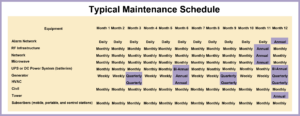This story was previously published in Mission Critical Communications March 2016 by TUSA Consultant Dean Hart.
Detailed preventative maintenance plans and schedules are necessary for all components of a radio network from the start of warranty through end of life.
Once a new radio network is under construction; it is important to examine questions about the warranty or extended warranty. What will be covered during that warranty period? What levels and what schedule of preventative maintenance should be performed during the warranty period? What should the customer reasonably expect the warranty to exclude? What should the customer plan and budget for while the radio network is being built? It all starts with what was purchased. Typical radio networks are more than just installed technology.
A construction project includes towers, shelters, generators, and other support infrastructure deployed to meet coverage, capacity and connectivity expectations associated with the dispatch center consoles, mobiles and portables purchased with the contract. Maintaining the supporting infrastructure is as important as the radio equipment. A new radio network typically contains towers; civil components such as fencing, grounding and site access; shelters; heating, ventilation, and air conditioning (HVAC) equipment; generators; uninterruptible power supply (UPS) or battery plants; RF infrastructure such as antennas and lines, repeaters, consoles, and alarm networks; the IT network; microwave, fiber, or landline connectivity; and mobile or portable subscriber units.
All of this equipment and supporting infrastructure have specifications, installation guidelines and usually some form of specification acceptance required during construction and implementation. This creates a baseline to which all future inspections and technical information are compared to ensure the maintained network is still in the same condition as the accepted network. For each major portion of the radio network, there should be some level of preventative maintenance during the warranty period, as well as a future preventative maintenance schedule. Some examples of maintenance activities for various components of the radio network follow.
Maintenance Activities
For towers, periodic inspections to ensure antennas and other mounting hardware are structurally intact are key. Tower lighting is usually monitored through the alarm network. Grounding inspections should examine the tower legs and ice shield. FCC structural inspections usually require climbing the tower. Guyed and self-supporting towers should have an inspection routine.
Maintenance of civil components should include routine physical inspections to ensure the access road and fencing have not been damaged; weed control as needed; and grounding inspections on a routine basis, including an annual grounding measurement to compare against the installed baseline.
Shelter maintenance should include cleaning to prevent dust and dirt getting into the electronics, checking outside and inside lighting, making sure door locks are lubricated as needed to ensure door entry, performing grounding inspections to ground bus bars (inside and outside) and internal grounding connections to halo and interior racks, and inspecting for water leaks or vermin/bug intrusion.
HVAC maintenance should include periodic inspections and filter changes; checks of mechanical components for tightness, lubrication, and proper operation; and checks to ensure proper operation for temperature control.
A weekly exercise of generators under site load should be performed, as well as periodic inspection of cooling, battery, engine, fuel, electrical and transfer switch systems. Oil changes and scheduled preventative maintenance should be performed according to use. UPS and battery plants require periodic inspection of air flow (fans cleaned), input and output voltage, and system parameters, as well as checks y of the UPS bypass switch to ensure the system is operating properly.
The RF infrastructure should periodically be inspected to ensure all fans are clean and unobstructed from dust. Repeater (transmission, receive and deviation) specifications should be compared against baseline measurements; input and output levels for connectivity must be checked to ensure they are still within specifications.
RF antenna sweeps should be compared against baseline measurements and tower-top amplifiers inspected to ensure bypass mode and proper operation. The alarm network should be validated to the sensors.
Inspections of the IT network should ensure all fans are clean and unobstructed from dust. Software updates, including to operating systems, must be performed to ensure security updates are current.
Microwave, fiber, or landline connectivity equipment should be checked to make sure input and output levels for connectivity are still within specifications. Microwave transmit and receive frequencies can be measured and compared against the baseline, and battery rectifier systems should be checked for proper operating voltages and alarm conditions.
Subscriber units should receive a visual inspection of knobs, case, battery contacts and antenna connections, and testing on a bench for proper manufacturer specifications. New service monitors are capable of auto test setups and functions that can test a mobile and portable against manufacturer specifications.
These are typical maintenance routines that should be performed at least once during the warranty period of a radio network. A customer should determine from the vendor, according to how the network was built, what routine maintenance and schedule will be provided and completed during the warranty period.
Performance of Maintenance
The customer may have responsibilities in this matrix as well, such as daily monitoring of the alarms, although the vendor may remotely monitor these conditions. This keeps the customer in tune with different events and provides oversight of the vendor managing or maintaining the network during the warranty period.
The customer should also be a part of random monthly inspections to verify that site components are maintained in the same condition they were in when the system was accepted or to confirm that the site is OK after completion of a preventative maintenance procedure. If a customer organization plans to use its own technical staff to maintain the site, the customer should participate in the scheduled preventative maintenance as a good training tool for after the warranty cycle.
The vendor should also provide detailed documentation of the warranty procedures and when the preventative maintenance is scheduled. There may be downtime associated with the preventative maintenance, and the customer will have to make sure that doesn’t impact operations or request that the preventative maintenance be scheduled during off-peak hours.
The same technical personnel who optimized the network may not be the technical personnel performing the preventative maintenance. The customer should be aware of the technical training, qualifications, and certifications of these personnel to ensure continued use of proper maintenance techniques.
Often, a vendor integrating a new radio network will outsource the majority of the maintenance on equipment that it typically doesn’t manufacture, such as the towers, generators, UPS and shelters. The customer should be aware of these vendors or other comparable vendors, as the customer may have the option to outsource these services after the warranty is complete. The customer should also be aware of the types of preventative maintenance procedures being performed and ensure that the response times and procedures properly support a public-safety shops.
The customer should know how and when preventative measures will be performed on the equipment during the warranty period. The same documents that were used to optimize the equipment and provide the baseline can continue to be used for future preventative maintenance. This allows comparison from year to year to see if any degradation is occurring, which is especially important on the antenna systems.
Lightning, water damage or incidental damage from other work on the tower can lead to slow, long-term degradation of an antenna system that eventually results in degraded coverage to the users. Sweeping the antennas on a yearly basis and comparing against the baseline can provide valuable insight to avoid this problem.
Maintenance Outside of Warranty
After the warranty is completed, it is reasonable for the customer to be handed a network that is in the same condition as when the network and all the purchased and installed components of the infrastructure were accepted. The customer should be given detailed preventative maintenance documents that show the work was actually completed and maintain the records along with the acceptance records to continually compare each preventative maintenance cycle against previous cycles to ensure no degradation is occurring.
Lightning and electrical surges are probably the most frustrating items that are not covered under a warranty maintenance program. Vendors cannot anticipate nor prevent a force majeure type of incident. The customer should plan for unexpected events and work with the vendor to determine root causes and preventative measures in the event that a lightning strike occurs during or after the warranty cycle. The customer should budget funds to cover these unanticipated events during the warranty cycle.
It is also reasonable for the customer to ensure preventative maintenance on reused components — typically towers, generators and shelters — are kept to the same levels as expected by vendors. The reused components are likely in place to support the current radio network, as well as provide future support for the new network. If the reused components are under a maintenance plan, that plan should continue during the implementation cycle and warranty period and through the life cycle of the item.
Detailed preventative maintenance plans and schedules should be in place for all network components from the start of warranty through the end of the life cycle. The implementation cycle and the warranty period provide a good time frame for the customer to become intimately familiar with all the preventative maintenance processes, schedules, documentation, and the specific vendor performing the work.

None of these processes should be taken for granted. The customer should not have to wonder if the vendor is truly providing the proper levels of maintenance during the warranty period. Public-safety organizations can’t afford to have a network fail or slowly degrade because of ignored, deferred or improper maintenance at any time.
Dean Hart is the CEO at TUSA Consulting Services. He has experience with large networks such as Florida’s Statewide Law Enforcement Radio System (SLERS), Virginia’s Statewide Agencies Radio System (STARS), the Missouri Statewide Interoperability Network (MOSWIN) and Kansas City’s Metropolitan Area Regional Radio System (MARRS). He has helped multiple customers with preventative maintenance planning of public-safety radio networks.


